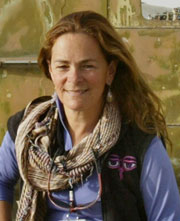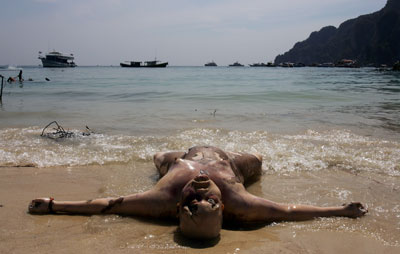 |
 | ||||
Thailand:
From the Land of Smiles January 2005
|
 |
|||
|
Three thousand people died on 9-11, but perhaps 100 times as many people died since 12-26 from the Asian Tsunami catastrophe, all in the space of minutes. This had nothing to do with terrorism, it was not man-made and I had never seen anything on this scale before. The phone call interrupted my relaxing day at the pool, moments later I was back at my office, and raced back to my apartment, packing in 10 minutes to catch the first flight I could from Bangkok to Phuket. The plane finally arrived at 10:00 pm after a 2-hour delay, and I hit the ground running. I didn't sleep until the following day. When I arrived the first challenge was immediate: no transport at the airport. Luckily I found a good friend and hopped in his car. The first images were dazed tourists, completely traumatized, in a terrible state of shock. Patong beach was destroyed, destruction was everywhere. After driving around empty streets in the darkened beach resort without any power we made it to the city hall where hundreds of survivors had horrific tales to tell. Children cried for their missing parents, everybody had a missing family member, it was heart wrenching to hear their stories. I found myself hugging many people to console them, but I was overwhelmed myself. The next few days were grueling, hellish. No matter where I went from Koh Phi Phi Island to Khao Lak, all I did is shoot and smell death. It was beyond mind-boggling, it was too much. Possibly the most intense day was on December 27 when I went to Koh Phi Phi. We were lucky to hitch a ride on a boat, I knew it was really bad there and but wasn't ready for what I saw. From the moment we landed we saw bodies lying on the dock and immediately hit by the unbelievable smell of rotting corpses, the heat making it worse. After shooting a few frames from the dock, I made my way to the oceanfront cabana resort where bodies dotted the landscape. I walked to the beach where workers were pulling them out from the sea. I just kept on shooting.
We moved quickly to document everything that was happening on the devastated island in Phi Phi village, on Ton Sai Bay, the narrow strip of land hit by the Tsunami from both sides. I decided I had to push myself to be where the rescue teams went even when it meant going into a small shop where 7 people were trapped, none of them had a chance, they had run from the wave only to be hit by a second one coming from the other side of the narrow bay. Over the following days it continued, the size and scope of the disaster was just unthinkable. I spent hours in makeshift morgues and had to document the families coming to find their missing family members. It's hard to explain how we as photojournalists deal with horrific sights, everyone has their own coping mechanisms but no matter what,it hits you later when you slow down, maybe at night when you are in bed. For me it was when I was with friends on New Year's Eve back in Bangkok. I was home for only one night before leaving for more coverage in Sri Lanka and was able to talk with good friends about my experiences and the emotion coming out. I grabbed a bottle of good French champagne already purchased for my (postponed) vacation to Bali, and took it to the bar, getting there just near midnight, popped the cork and dropped to the floor.
© Paula Bronstein
Dispatches are brought to you by Canon. Send Canon a message of thanks. |
||||
Back to January 2005 Dispatches
|
|

